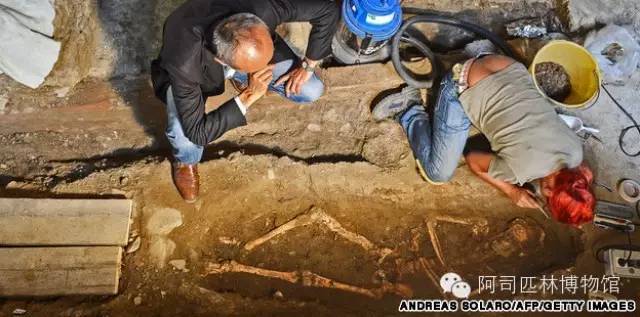
Five not-to-be-missed archaeological sites
People find ruins and create ruins.
brush off the dust and uncover the new side of history, art, and mystery. Now, is she the charming prototype of Leonardo da Vinci's Mona Lisa? Time and DNA will answer everything.
A Mesolithic site about 10,000 years ago was recently excavated in Scotland.
this native land may have been founded by people living in Scotland after the most recent ice age.
for a long time, many other archaeological excavations around the world bring visitors closer to history.
1, Saint Ursula Monastery, Florence, Italy
A final resting place for artistic secrets?
the identity mystery behind Leonardo da Vinci's Mona Lisa has perplexed people for centuries. Can St. Ursula Monastery reveal this secret forever?
Archaeologists claim they may have found the bones of the Mona Lisa.
the bones unearthed may belong to Lisa Giardini, who modeled for a painter in 1504. She married a wealthy silk merchant named Francisco Dale Joe Gondo, and her husband became a widow after his death. After she died in 1542, she was buried in a monastery.
in Italy, the Mona Lisa is called "Mrs. Qiao Conda" because of the connection between the two women.
it took archaeologists nearly a year to excavate the site, which is 2 meters below the surface of the monastery.
once the identity of the skeleton is confirmed by DNA, the archaeologist will use the skull to compare the shape of the face in Leonardo da Vinci's painting.
2, the tomb of Apis, Cairo
this is the place where divine cattle are buried.
Sajala's Serapeum, also known as the Tomb of Apis, has been reopened to the public after 10 years of renovation.
the tomb dates back to 1400 BC and was discovered by the archaeologist Auguste Mariette in 1851.
the burial site is famous for the giant granite sarcophagus of the sacred cow "Apis" believed by the pharaohs. The tomb weighs 60 to 70 tons.
the roof of the site and the ancient tombs along the underground corridors are now protected by wooden scaffolding and iron plates.
the whole restoration process realizes the safety consideration for tombs and visitors by improving the ventilation, safety, and lighting system inside and outside the site.
for more information about tours and tours to the Tomb of Apis, please visit www.egypttourinfo.com, or visit the official Egyptian Tourism website.
3, Leicester skeletons, England
pray for a royal reunion.
although it is not 100% certain, scientists and archaeologists claim that there is strong evidence that the skeleton of King Richard III, who ruled England from 1483 to 1485, was discovered in the central English city of Leicester.
The excavation began in August 2012 when archaeologists searched for Richard III's last resting place. This used to be a parking lot, and it's underground is the ruins of a church. The bones were found at the site of the church choir.
according to Richard Taylor of the University of Leicester, the skeleton aroused "great interest" from several different factors, including the location of the spine, the location of the burial, and a fatal wound on the skull caused by a sharp weapon.
the evidence seems to be very strong, but it is a long time ago, and further analysis and confirmation are necessary. Visitors can visit the ruins, but they can't expect a royal reception for the time being.
for more information, visit the University of Leicester website Leicester University website.
4, Jewish Garden, Germany
parking is prohibited unless you have a shovel and a fine brush!
on December 28th, Berlin received gifts from history while celebrating the city's 775th anniversary.
the foundation of a 17th-century house in Grosser Juedenhof, literally translated as "the Great Jewish Garden" has been found. All kinds of archaeological activities and exhibitions are often held around Berlin.
this garden used to be a parking lot, but now archaeologists have discovered a medieval synagogue and public bath.
Look gorgeous on any occasion in our goth prom dresses. Options in different styles and silhouettes are available right now!
this year, there was another interesting discovery south of the Palace Square on Berlin's Museum Island.
here, archaeologists have discovered the old foundation of St. Peter's Cathedral, the ruins of the sister town of Colln in ancient Berlin, and the remains of more than 4000 people belonging to the town's earliest residents.
Click here to hear, more information.
5. After the Mayan War, Guatemala
as shown in the picture, just more spears, and blades.
Archaeologists recently discovered a tomb in Guatemala after the ancient Mayan War, rewriting speculation about the political status of women in the classical Mayan period.
experts say Queen K\ & # 39 Madame Abel is considered to be the military ruler of the ancient Maya.
"Mrs. K\ & # 39 * * Abel is buried in a temple 11 meters below the surface, next to the stairs," archaeologist leader David Friedl, "K\ & # 39 * Abel is not a normal person. Burying her in that location shows that it is very important; it also shows that people still worship her after the fall of the dynasty. "
there is other evidence of skeletal social status in the burial site, including ceramic containers, jade jewelry, and memorial ceremonies. Mrs. L's large bone carving.
because of its remote location, it is still difficult to travel to the tomb.